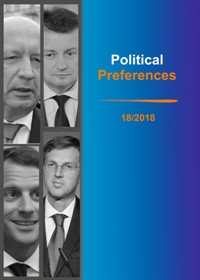Allport, G. W. (1935). Attitudes. In: C. Murchison (Ed.), A handbook of Social Psychology (pp. 798–844). Worcester, MA: Clark University Press.
Google Scholar
Converse, P. (1964). The nature of belief systems in mass publics. In: D. Apter (Ed.) Ideology and discontent (pp. 206–61). New York: Free Press.
Google Scholar
Diamond, L., & Morlino, L. (2005). Introduction. In: L. Diamond, & L. Morlino (Eds.), Assessing the quality of democracy (pp. ix–xlii). Baltimore: Johns Hopkins University Press.
Google Scholar
Dobek-Ostrowska, B, Głowacki, M., Jakubowicz, K., & Sükösd, M. (Eds.) (2010). Comparative Media Systems. European and Global Perspective. Budapest: CEU Press.
Google Scholar
Entman, R.M. (1993). Framing: toward clarification of a fractured paradigm. Journal of communication, 43(4), 51–58.
Google Scholar
Fazio, R.H. (1990). Multiple processes by which attitudes guide behavior: The MODE model as an integrative framework. In: M. P Zanna (Ed.) Advances in experimental social psychology (pp. 75–109). New York: Academic Press.
Google Scholar
Goldman, S. K., & Mutz, D. C. (2011). The Friendly Media Phenomenon: A Cross- National Analysis of Cross-Cutting Exposure. Political Communication, 28(1), 42–66.
Google Scholar
Habermas, J. (2008). Strukturalne przeobrażenia sfery publicznej. Warszawa: PWN.
Google Scholar
Hallin, D. C., & Mancini, P. (2004). Comparing Media Systems: Three Models of Media and Politics. Cambridge: Cambridge University Press.
Google Scholar
Hargittai, E., & Walejko, G. (2008). The Participation Divide: Content Creation and Sharing in the Digital Age. Information, Communication and Society, 11(2), 239–56.
Google Scholar
Hargittai, E. (2002). Second-level Digital Divide: Differences in People’s Online Skills. First Monday, 7(4).
Google Scholar
Hargittai, E. (2008). The Role of Expertise in Navigating Links of Influence. In: J. Turow, & L. Tsui (Eds.), The Hyperlinked Society. (pp. 85–103). Ann Arbor, MI: University of Michigan Press.
Google Scholar
Lerner, D. (1958). The Passing of Traditional Society. New York: Free Press.
Google Scholar
Lipset, S. M. (1959). Some social prerequisites of democracy: Economic development and political legitimacy. American Political Science Review, 53, 69–105.
Google Scholar
Maier, J., & Rittberger, B. (2008). Shifting Europe’s Boundaries: Mass Media, Public Opinion and the Enlargement of the EU. European Union Politics, 9(2), 243–67.
Google Scholar
Matthes, J. & Schemer, C. (2012). Diachronic Framing Effects in Competitive Opinion Environments. Political Communication, 29(3), 319–39.
Google Scholar
Mungiu-Pippidi, A. (2013). Freedom without impartiality. The vicious circle of media capture. In: P. Gross, & K. Jakubowicz (Eds.), Media transformations in the post-communist world: Eastern Europe's Tortured Path to Change (pp. 33–47). Lanham, MD: Lexington Books.
Google Scholar
Norris, P. (2000). A Virtuous Circle: Political Communications in Postindustrial Societies. Cambridge University Press.
Google Scholar
Pye, L. W. (1963). Communications and Political Development. Princeton, NJ: Princeton University Press.
Google Scholar
Štětka, V. (2013). Media Ownership and Commercial Pressures – Pillar 1 Final report. https://mde.politics.ox.ac.uk/images/Final_reports/stetka_2013_final%20report_posted.pdf (10/01/2018).
Google Scholar
Tourengau, R., Rips, L.J., & Rasinski, K. (2000). The psychology of survey response. New York: Cambridge University Press.
Google Scholar
Zaller, J. R. (1992). The Nature and Origins of Mass Opinion. Cambridge University Press.
Google Scholar



 10.31261/polpre
10.31261/polpre